Chang Yun Chung: Difference between revisions
Dayana Rizal (talk | contribs) |
Dayana Rizal (talk | contribs) No edit summary |
||
| Line 31: | Line 31: | ||
Yun Chung joined Kie Hock Shipping Company in 1948. At the time, the company was known as Thye Hin Guan Brothers - a produce firm run by three brothers.<ref>Chew, Melanie. “Chang Yun Chung,” in ''Leaders of Singapore,'' 251-256. Singapore : World Scientific Publishing Co. Pte. Ltd., 1996.</ref> Yun Chung was appointed the General Manager and after a year, he had helped the brothers to form Kie Hock Shipping Company, having also secured the company's first vessel for S$100,000.<ref>Chew, Melanie. “Chang Yun Chung,” in ''Leaders of Singapore,'' 251-256. Singapore : World Scientific Publishing Co. Pte. Ltd., 1996.</ref> Yun Chung helped to build up the company’s fleet from just one landing vessel in 1949 to 32 shipping vessels in 1967.<ref>Chew, Melanie. “Chang Yun Chung,” in ''Leaders of Singapore,'' 251-256. Singapore : World Scientific Publishing Co. Pte. Ltd., 1996.</ref> During this period, Yun Chung also served in the capacity of a Director in several other Asian shipping companies, including Hong Kong’s Tranpac Shipping Enterprises Limited.<ref>Benson, Emmanuel Abara. “[https://nairametrics.com/2018/11/30/the-worlds-oldest-billionaire-is-singaporean-chang-yun-chung/ Story of the World's Oldest Billionaire Will Inspire You a Lot]”. ''Nairametrics''. November 30, 2018. Accessed 12 December 2019.</ref> In 1956, Yun Chung was part of a business delegation visiting China that was led by then-Chief Minister David Marshall.<ref>“PIL sailing in the right direction.” ''The Edge Singapore.'' January 31, 2005. Accessed 12 December 2019. Retrieved from Factiva. </ref> | Yun Chung joined Kie Hock Shipping Company in 1948. At the time, the company was known as Thye Hin Guan Brothers - a produce firm run by three brothers.<ref>Chew, Melanie. “Chang Yun Chung,” in ''Leaders of Singapore,'' 251-256. Singapore : World Scientific Publishing Co. Pte. Ltd., 1996.</ref> Yun Chung was appointed the General Manager and after a year, he had helped the brothers to form Kie Hock Shipping Company, having also secured the company's first vessel for S$100,000.<ref>Chew, Melanie. “Chang Yun Chung,” in ''Leaders of Singapore,'' 251-256. Singapore : World Scientific Publishing Co. Pte. Ltd., 1996.</ref> Yun Chung helped to build up the company’s fleet from just one landing vessel in 1949 to 32 shipping vessels in 1967.<ref>Chew, Melanie. “Chang Yun Chung,” in ''Leaders of Singapore,'' 251-256. Singapore : World Scientific Publishing Co. Pte. Ltd., 1996.</ref> During this period, Yun Chung also served in the capacity of a Director in several other Asian shipping companies, including Hong Kong’s Tranpac Shipping Enterprises Limited.<ref>Benson, Emmanuel Abara. “[https://nairametrics.com/2018/11/30/the-worlds-oldest-billionaire-is-singaporean-chang-yun-chung/ Story of the World's Oldest Billionaire Will Inspire You a Lot]”. ''Nairametrics''. November 30, 2018. Accessed 12 December 2019.</ref> In 1956, Yun Chung was part of a business delegation visiting China that was led by then-Chief Minister David Marshall.<ref>“PIL sailing in the right direction.” ''The Edge Singapore.'' January 31, 2005. Accessed 12 December 2019. Retrieved from Factiva. </ref> | ||
===Founder & Chairman of Pacific International Lines (PIL) (1967 - present)=== | ===Founder & Chairman of Pacific International Lines (PIL) (1967 - present)=== | ||
[[File:Chang Yun Chung and Teo Siong Seng.jpg|thumb|''Chang Yun Chung | [[File:Chang Yun Chung and Teo Siong Seng.jpg|thumb|''Chang Yun Chung and his fifth son, Teo Siong Seng. Photo from [https://www.cnbc.com/2018/12/05/worlds-oldest-billionaire-yun-chung-chang-goes-to-work-every-day.html CNBC].'']] | ||
Yun Chung set up Pacific International Lines (PIL) in March 1967 after leaving Kie Hock Shipping.<ref>Oon, Clarissa. “Survivor of the high seas.” ''The Straits Times.'' October 31, 2011. Accessed 13 December 2019. Retrieved from NewspaperSG.</ref> He was 49 years old at the time. PIL started with two second-hand Dutch freighters named Kota Singa ex Siberot and Kota Naga ex Sinabang.<ref>Faulder, Dominic. “[https://asia.nikkei.com/Spotlight/Cover-Story/The-silver-tsunami-Ten-nonagenarians-who-shaped-Asia-in-2018 The 'silver tsunami': Ten nonagenarians who shaped Asia in 2018]”. ''Nikkei Asian Review.'' January 2, 2019. Accessed 13 December 2019.</ref><ref>“[https://www.pilship.com/data/menu/pil_corporate_brochure.pdf PIL Corporate Brochure]”. ''Pacific International Lines''. Singapore, SG: Pacific International Lines, 2012. Accessed 13 December 2019.</ref> The first PIL office was in a shophouse at Market Street.<ref>Joseph, George. “Father-son success story.” ''The Business Times.'' May 13, 2006. Accessed 18 November 2019. Retrieved from NewspaperSG.</ref> Within the same year of their incorporation, PIL opened their first overseas office in Jakarta.<ref>“[https://www.pilship.com/data/menu/pil_corporate_brochure.pdf PIL Corporate Brochure]”. ''Pacific International Lines''. Singapore, SG: Pacific International Lines, 2012. Accessed 13 December 2019.</ref> | Yun Chung set up Pacific International Lines (PIL) in March 1967 after leaving Kie Hock Shipping.<ref>Oon, Clarissa. “Survivor of the high seas.” ''The Straits Times.'' October 31, 2011. Accessed 13 December 2019. Retrieved from NewspaperSG.</ref> He was 49 years old at the time. PIL started with two second-hand Dutch freighters named Kota Singa ex Siberot and Kota Naga ex Sinabang.<ref>Faulder, Dominic. “[https://asia.nikkei.com/Spotlight/Cover-Story/The-silver-tsunami-Ten-nonagenarians-who-shaped-Asia-in-2018 The 'silver tsunami': Ten nonagenarians who shaped Asia in 2018]”. ''Nikkei Asian Review.'' January 2, 2019. Accessed 13 December 2019.</ref><ref>“[https://www.pilship.com/data/menu/pil_corporate_brochure.pdf PIL Corporate Brochure]”. ''Pacific International Lines''. Singapore, SG: Pacific International Lines, 2012. Accessed 13 December 2019.</ref> The first PIL office was in a shophouse at Market Street.<ref>Joseph, George. “Father-son success story.” ''The Business Times.'' May 13, 2006. Accessed 18 November 2019. Retrieved from NewspaperSG.</ref> Within the same year of their incorporation, PIL opened their first overseas office in Jakarta.<ref>“[https://www.pilship.com/data/menu/pil_corporate_brochure.pdf PIL Corporate Brochure]”. ''Pacific International Lines''. Singapore, SG: Pacific International Lines, 2012. Accessed 13 December 2019.</ref> | ||
==== Growth & recognition ==== | ====Growth & recognition==== | ||
PIL was the first few companies to break into the Chinese market.<ref>Chen, Huifen. “Charting the course of PIL.” ''The Business Times.'' February 3, 2005. Accessed 12 December 2019. Retrieved from NewspaperSG. </ref> They established trade links with China and launched three new routes: one to East Africa, one to the Persian Gulf and one to the Red Sea.<ref>Chen, Huifen. “Charting the course of PIL.” ''The Business Times.'' February 3, 2005. Accessed 12 December 2019. Retrieved from NewspaperSG. </ref> As PIL was one of the first local shipping companies in Singapore at the time, Yun Chung convinced then-Finance Minister Goh Keng Swee to award PIL with the “Pioneer Status”.<ref>Oon, Clarissa. “Survivor of the high seas.” ''The Straits Times.'' October 31, 2011. Accessed 13 December 2019. Retrieved from NewspaperSG.</ref> This status granted the company tax exemptions on profits, provided that half of the staff were Singaporeans and half of all the ship repairs were done in Singapore.<ref>Oon, Clarissa. “Survivor of the high seas.” ''The Straits Times.'' October 31, 2011. Accessed 13 December 2019. Retrieved from NewspaperSG.</ref> By the 1990s, PIL had expanded to serve 83 countries and ports.<ref>“[https://www.pilship.com/en-our-history-and-milestones-pil-pacific-international-lines/82.html#content_2 Our Local Agents]”. ''Pacific International Lines.'' Accessed 23 December 2019.</ref> In 2018, Yun Chung officially handed over the chairmanship of PIL to his son, [[Teo Siong Seng|Siong Seng]], while he went on to serve as Chairman Emeritus.<ref>Faulder, Dominic. “[https://asia.nikkei.com/Spotlight/Cover-Story/The-silver-tsunami-Ten-nonagenarians-who-shaped-Asia-in-2018 The 'silver tsunami': Ten nonagenarians who shaped Asia in 2018]”. ''Nikkei Asian Review.'' January 2, 2019. Accessed 13 December 2019.</ref> | PIL was the first few companies to break into the Chinese market.<ref>Chen, Huifen. “Charting the course of PIL.” ''The Business Times.'' February 3, 2005. Accessed 12 December 2019. Retrieved from NewspaperSG. </ref> They established trade links with China and launched three new routes: one to East Africa, one to the Persian Gulf and one to the Red Sea.<ref>Chen, Huifen. “Charting the course of PIL.” ''The Business Times.'' February 3, 2005. Accessed 12 December 2019. Retrieved from NewspaperSG. </ref> As PIL was one of the first local shipping companies in Singapore at the time, Yun Chung convinced then-Finance Minister Goh Keng Swee to award PIL with the “Pioneer Status”.<ref>Oon, Clarissa. “Survivor of the high seas.” ''The Straits Times.'' October 31, 2011. Accessed 13 December 2019. Retrieved from NewspaperSG.</ref> This status granted the company tax exemptions on profits, provided that half of the staff were Singaporeans and half of all the ship repairs were done in Singapore.<ref>Oon, Clarissa. “Survivor of the high seas.” ''The Straits Times.'' October 31, 2011. Accessed 13 December 2019. Retrieved from NewspaperSG.</ref> By the 1990s, PIL had expanded to serve 83 countries and ports.<ref>“[https://www.pilship.com/en-our-history-and-milestones-pil-pacific-international-lines/82.html#content_2 Our Local Agents]”. ''Pacific International Lines.'' Accessed 23 December 2019.</ref> In 2018, Yun Chung officially handed over the chairmanship of PIL to his son, [[Teo Siong Seng|Teo Siong Seng]], while he went on to serve as Chairman Emeritus.<ref>Faulder, Dominic. “[https://asia.nikkei.com/Spotlight/Cover-Story/The-silver-tsunami-Ten-nonagenarians-who-shaped-Asia-in-2018 The 'silver tsunami': Ten nonagenarians who shaped Asia in 2018]”. ''Nikkei Asian Review.'' January 2, 2019. Accessed 13 December 2019.</ref> | ||
==Personal life== | ==Personal life== | ||
[[File:Teo Siong Seng and family.jpg|thumb|''Chang Yun Chung with three of his children. Photo from [https://www.forbes.com/sites/jonburgos/2019/08/28/singapores-richest-2019-at-101-the-worlds-oldest-billionaire-has-no-plans-to-slow-down/#3641b8391f70 Forbes].'']] | [[File:Teo Siong Seng and family.jpg|thumb|''Chang Yun Chung with three of his children. Photo from [https://www.forbes.com/sites/jonburgos/2019/08/28/singapores-richest-2019-at-101-the-worlds-oldest-billionaire-has-no-plans-to-slow-down/#3641b8391f70 Forbes].'']] | ||
Revision as of 14:06, 9 September 2020
Chang Yun Chung | |
|---|---|
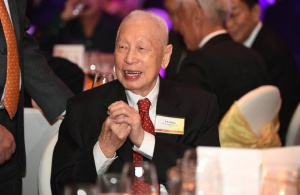 | |
| Born | 1918 Kinmen, Fujian Province, China |
| Died | 4 September 2020 |
| Alma mater | Xiamen Datung College |
| Known for | Pacific International Lines (PIL) founder |
Chang Yun Chung (born 1918 - 2020) - also known as Teo Woon Tiong (张允中) - is the founder of Pacific International Lines (PIL), a shipping company based in Singapore.[1] Before his passing in 2020, the Singapore Permanent Resident was formerly known as the oldest billionaire in the world.[2][3] He also holds Malaysian citizenship and honorary citizenship in three Chinese port cities - Shanghai, Dalian and Penglai, Shandong.[4]
Early life
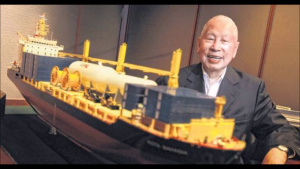
Family
Yun Chung was born in Shawei Town on Quemoy (also known as Kinmen), a small island in Fujian province, China. He was born to Chang Wenxia - a Chinese sinseh - and Huang Yuyan in 1918.[5][6][7][8] Yun Chung's family owned large plots of agricultural land and numerous shophouses. On top of this, they were also in the furniture trade and ran Traditional Chinese Medicine businesses.[9]
Education
Yun Chung enrolled in the Pu Xian Cheng Kinmen High School at 10 years old.[10] When the Fujian Rebellion struck, he transferred to Xiamen Da Tong College.[11][12][13] Yun Chung’s father came to Singapore in 1935 while his mother, his five siblings and himself remained in Quemoy.[14]
Life during the Japanese Occupation
When Japan invaded China in 1937, Quemoy was the first island they occupied. Yun Chung was the first in his family to flee to Singapore. His mother and siblings followed suit about two months later.[15]
Arrest in Malacca
In 1940, Yun Chung moved to Malacca to do business with his maternal uncle.[16] His uncle would bring produce from Sumatra while Yun Chung ran the business in Malacca. When the Japanese occupied Malacca in 1941, Yun Chung fled to a rubber estate seven miles away from Malacca.[17] However, he was caught twice by the Japanese - once in 1942 and once in 1944 - for supplying food and medicine to the Anti-Japanese Army.[18] When Yun Chung was arrested in 1944, he was kept in jail for a year until the Japanese surrender, when he was released.[19] He was supposed to be hung or shot while in prison but was kept alive when his mother gave away her possessions to the head of the Kempeitai.[20]
Return to Singapore
When the war ended, Yun Chung returned to Singapore to find his father. It was then he realised that his father had been killed by the Japanese. His mother accompanied him back to Malacca where he continued to run the business with his uncle and learnt “a bit of shipping from there”.[21]
Career
Early career (1945)
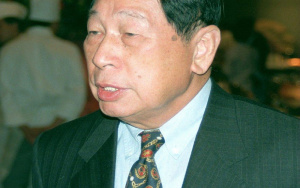
In 1945, Yun Chung left Malacca and returned to Singapore where he started up his first import-export business.[22] With his initial capital, he bought ships and dabbled in trade with Sumatra and Java. However, his business failed.[23]
General Manager of Kie Hock Shipping Company (1948 - 1967)
Yun Chung joined Kie Hock Shipping Company in 1948. At the time, the company was known as Thye Hin Guan Brothers - a produce firm run by three brothers.[24] Yun Chung was appointed the General Manager and after a year, he had helped the brothers to form Kie Hock Shipping Company, having also secured the company's first vessel for S$100,000.[25] Yun Chung helped to build up the company’s fleet from just one landing vessel in 1949 to 32 shipping vessels in 1967.[26] During this period, Yun Chung also served in the capacity of a Director in several other Asian shipping companies, including Hong Kong’s Tranpac Shipping Enterprises Limited.[27] In 1956, Yun Chung was part of a business delegation visiting China that was led by then-Chief Minister David Marshall.[28]
Founder & Chairman of Pacific International Lines (PIL) (1967 - present)
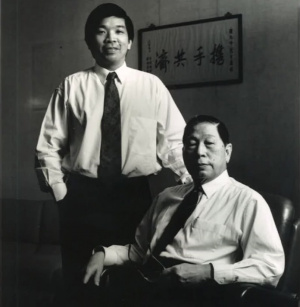
Yun Chung set up Pacific International Lines (PIL) in March 1967 after leaving Kie Hock Shipping.[29] He was 49 years old at the time. PIL started with two second-hand Dutch freighters named Kota Singa ex Siberot and Kota Naga ex Sinabang.[30][31] The first PIL office was in a shophouse at Market Street.[32] Within the same year of their incorporation, PIL opened their first overseas office in Jakarta.[33]
Growth & recognition
PIL was the first few companies to break into the Chinese market.[34] They established trade links with China and launched three new routes: one to East Africa, one to the Persian Gulf and one to the Red Sea.[35] As PIL was one of the first local shipping companies in Singapore at the time, Yun Chung convinced then-Finance Minister Goh Keng Swee to award PIL with the “Pioneer Status”.[36] This status granted the company tax exemptions on profits, provided that half of the staff were Singaporeans and half of all the ship repairs were done in Singapore.[37] By the 1990s, PIL had expanded to serve 83 countries and ports.[38] In 2018, Yun Chung officially handed over the chairmanship of PIL to his son, Teo Siong Seng, while he went on to serve as Chairman Emeritus.[39]
Personal life
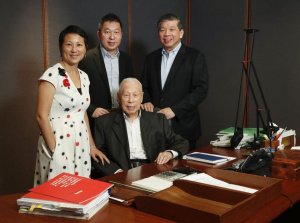
Wife & children
Yun Chung married his first wife, Madam Yap Hong, in 1941, the same year that he met her.[40] She passed away on 4 April 1990.[41] He is said to have at least three wives and fourteen children, eight sons and six daughters.[42] Most of his children work in PIL, although all of them had to start from the bottom and work their way up.[43] His son, Teo Siong Seng, is the current Executive Chairman of Pacific International Lines (PIL).
Health
When he was younger, Yun Chung woke up at 6 AM every morning and jogged daily at the Singapore Botanic Gardens.[44] Although he had undergone spinal operations between the 1980s and the 1990s, he remained active in the day-to-day operations of PIL as the executive chairman at the time.[45] In his advanced age, Yun Chung keeps active by playing golf twice a week. Yun Chung has never smoked, hardly drinks and does not go out at night.[46] His favourite food is a bowl of sweet potato porridge.[47]
Charity work
Yun Chung has taken a proactive role in charity events. He gives greater attention to educational causes.[48]
Educational development in Kinmen, China
Yun Chung and his late brothers Yun Chong and Yean Fock had donated NT$10 million to set up an educational fund in their hometown, Kinmen. The fund was meant to help children who were living in poverty as well as to reward and nurture exceptional students on the island.[49] In September 2011, Yun Chung donated NT$10 million to set up the National Kinmen University Development Fund. The university renamed its design school to Chang Yun Chung Design School as a gesture of appreciation.[50]
Disaster relief
He has contributed to various disaster relief efforts such as the snow disaster in China, the Sichuan earthquake in 2008, the 921 earthquake in Taiwan (1999) and other natural calamities in Southeast Asia, Middle East and Africa.[51]
Awards & accolades
In 2011, Yun Chung was awarded the Excellence Award at the Business China Awards for pioneering cargo services between China and the rest of the world.[52][53] He also served as the Chairman of the Singapore Shipping Association from 1979 to 1981.[54][55]
References / Citations
- ↑ Chew, Melanie. “Chang Yun Chung,” in Leaders of Singapore, 251-256. Singapore : World Scientific Publishing Co. Pte. Ltd., 1996.
- ↑ Leong, Grace. "Shipping tycoon Teo Woon Tiong dies at 102". The Straits Times. September 9, 2020. Accessed on 9 September 2020.
- ↑ Oon, Clarissa. “Survivor of the high seas.” The Straits Times. October 31, 2011. Accessed December 13, 2019. Retrieved from NewspaperSG.
- ↑ Oon, Clarissa. “Survivor of the high seas.” The Straits Times. October 31, 2011. Accessed December 13, 2019. Retrieved from NewspaperSG.
- ↑ Chan, Paul. “#SecretsSelfMadeBillionaires 0067 Chang Yun Chung World's OldestSelfmadeBillionaire Age 99”. YouTube. April 15, 2017. Accessed 12 December 2019.
- ↑ Koh, Angela. “Childhood days in Kinmen,” in Chang Yun Chung: Steering through the Storms, 31-41. Singapore: Focus Publishing Ltd., 2012.
- ↑ Chew, Melanie. “Chang Yun Chung,” in Leaders of Singapore, 251-256. Singapore : World Scientific Publishing Co. Pte. Ltd., 1996.
- ↑ Chew, Melanie. “Chang Yun Chung,” in Leaders of Singapore, 251-256. Singapore : World Scientific Publishing Co. Pte. Ltd., 1996.
- ↑ Koh, Angela. “Childhood days in Kinmen,” in Chang Yun Chung: Steering through the Storms, 31-41. Singapore: Focus Publishing Ltd., 2012.
- ↑ Koh, Angela. “Childhood days in Kinmen,” in Chang Yun Chung: Steering through the Storms, 31-41. Singapore: Focus Publishing Ltd., 2012.
- ↑ Chew, Melanie. “Chang Yun Chung,” in Leaders of Singapore, 251-256. Singapore : World Scientific Publishing Co. Pte. Ltd., 1996.
- ↑ Benson, Emmanuel Abara. “Story of the World's Oldest Billionaire Will Inspire You a Lot”. Nairametrics. November 30, 2018. Accessed 12 December 2019.
- ↑ Koh, Angela. “Childhood days in Kinmen,” in Chang Yun Chung: Steering through the Storms, 31-41. Singapore: Focus Publishing Ltd., 2012.
- ↑ Chew, Melanie. “Chang Yun Chung,” in Leaders of Singapore, 251-256. Singapore : World Scientific Publishing Co. Pte. Ltd., 1996.
- ↑ Chan, Paul. “#SecretsSelfMadeBillionaires 0067 Chang Yun Chung World's OldestSelfmadeBillionaire Age 99”. YouTube. April 15, 2017. Accessed 12 December 2019.
- ↑ Chew, Melanie. “Chang Yun Chung,” in Leaders of Singapore, 251-256. Singapore : World Scientific Publishing Co. Pte. Ltd., 1996.
- ↑ Chew, Melanie. “Chang Yun Chung,” in Leaders of Singapore, 251-256. Singapore : World Scientific Publishing Co. Pte. Ltd., 1996.
- ↑ Chew, Melanie. “Chang Yun Chung,” in Leaders of Singapore, 251-256. Singapore : World Scientific Publishing Co. Pte. Ltd., 1996.
- ↑ Chew, Melanie. “Chang Yun Chung,” in Leaders of Singapore, 251-256. Singapore : World Scientific Publishing Co. Pte. Ltd., 1996.
- ↑ Chew, Melanie. “Chang Yun Chung,” in Leaders of Singapore, 251-256. Singapore : World Scientific Publishing Co. Pte. Ltd., 1996.
- ↑ Chew, Melanie. “Chang Yun Chung,” in Leaders of Singapore, 251-256. Singapore : World Scientific Publishing Co. Pte. Ltd., 1996.
- ↑ Chew, Melanie. “Chang Yun Chung,” in Leaders of Singapore, 251-256. Singapore : World Scientific Publishing Co. Pte. Ltd., 1996.
- ↑ Chew, Melanie. “Chang Yun Chung,” in Leaders of Singapore, 251-256. Singapore : World Scientific Publishing Co. Pte. Ltd., 1996.
- ↑ Chew, Melanie. “Chang Yun Chung,” in Leaders of Singapore, 251-256. Singapore : World Scientific Publishing Co. Pte. Ltd., 1996.
- ↑ Chew, Melanie. “Chang Yun Chung,” in Leaders of Singapore, 251-256. Singapore : World Scientific Publishing Co. Pte. Ltd., 1996.
- ↑ Chew, Melanie. “Chang Yun Chung,” in Leaders of Singapore, 251-256. Singapore : World Scientific Publishing Co. Pte. Ltd., 1996.
- ↑ Benson, Emmanuel Abara. “Story of the World's Oldest Billionaire Will Inspire You a Lot”. Nairametrics. November 30, 2018. Accessed 12 December 2019.
- ↑ “PIL sailing in the right direction.” The Edge Singapore. January 31, 2005. Accessed 12 December 2019. Retrieved from Factiva.
- ↑ Oon, Clarissa. “Survivor of the high seas.” The Straits Times. October 31, 2011. Accessed 13 December 2019. Retrieved from NewspaperSG.
- ↑ Faulder, Dominic. “The 'silver tsunami': Ten nonagenarians who shaped Asia in 2018”. Nikkei Asian Review. January 2, 2019. Accessed 13 December 2019.
- ↑ “PIL Corporate Brochure”. Pacific International Lines. Singapore, SG: Pacific International Lines, 2012. Accessed 13 December 2019.
- ↑ Joseph, George. “Father-son success story.” The Business Times. May 13, 2006. Accessed 18 November 2019. Retrieved from NewspaperSG.
- ↑ “PIL Corporate Brochure”. Pacific International Lines. Singapore, SG: Pacific International Lines, 2012. Accessed 13 December 2019.
- ↑ Chen, Huifen. “Charting the course of PIL.” The Business Times. February 3, 2005. Accessed 12 December 2019. Retrieved from NewspaperSG.
- ↑ Chen, Huifen. “Charting the course of PIL.” The Business Times. February 3, 2005. Accessed 12 December 2019. Retrieved from NewspaperSG.
- ↑ Oon, Clarissa. “Survivor of the high seas.” The Straits Times. October 31, 2011. Accessed 13 December 2019. Retrieved from NewspaperSG.
- ↑ Oon, Clarissa. “Survivor of the high seas.” The Straits Times. October 31, 2011. Accessed 13 December 2019. Retrieved from NewspaperSG.
- ↑ “Our Local Agents”. Pacific International Lines. Accessed 23 December 2019.
- ↑ Faulder, Dominic. “The 'silver tsunami': Ten nonagenarians who shaped Asia in 2018”. Nikkei Asian Review. January 2, 2019. Accessed 13 December 2019.
- ↑ Koh, Angela. “The days of refuge in Nanyang,” in Chang Yun Chung: Steering through the Storms, 43-55. Singapore: Focus Publishing Ltd., 2012.
- ↑ “Untitled.” The Straits Times. April 4, 1990. Accessed 13 December 2019. Retrieved from NewspaperSG.
- ↑ Lee, Bryan. “Singapore’s mystery millionaires.” The Straits Times. August 27, 2006. Accessed 12 December 2019. Retrieved from NewspaperSG.
- ↑ Koh, Angela. “Moving to back bench,” in Chang Yun Chung: Steering through the Storms, 161-173. Singapore: Focus Publishing Ltd., 2012.
- ↑ Indran, J. D. “Our King of the Seas”. The Straits Times. December 25, 1977. Accessed 11 December 2019.
- ↑ Oon, Clarissa. “Survivor of the high seas.” The Straits Times. October 31, 2011. Accessed 13 December 2019. Retrieved from NewspaperSG.
- ↑ Oon, Clarissa. “Survivor of the high seas.” The Straits Times. October 31, 2011. Accessed 13 December 2019. Retrieved from NewspaperSG.
- ↑ Oon, Clarissa. “Survivor of the high seas.” The Straits Times. October 31, 2011. Accessed 13 December 2019. Retrieved from NewspaperSG.
- ↑ Koh, Angela. “Moving to back bench,” in Chang Yun Chung: Steering through the Storms, 159-173. Singapore: Focus Publishing Ltd., 2012.
- ↑ Koh, Angela. “Moving to back bench,” in Chang Yun Chung: Steering through the Storms, 159-173. Singapore: Focus Publishing Ltd., 2012.
- ↑ Koh, Angela. “Moving to back bench,” in Chang Yun Chung: Steering through the Storms, 159-173. Singapore: Focus Publishing Ltd., 2012.
- ↑ Koh, Angela. “Moving to back bench,” in Chang Yun Chung: Steering through the Storms, 159-173. Singapore: Focus Publishing Ltd., 2012.
- ↑ Khoo, Lynette. “PIL founder clinches Business China award.” The Business Times. November 29, 2011. Accessed 11 December 2019. Retrieved from NewspaperSG.
- ↑ Tan, Melissa. “Business China honours shipping magnate.” The Straits Times. November 29, 2011. Accessed 11 December 2019. Retrieved from NewspaperSG.
- ↑ “New chairman for SSA”. The Business Times. May 22, 1979. Accessed 13 December 2019. Retrieved from NewspaperSG.
- ↑ “Shipping assn committee”. The Straits Times. June 13, 1981. Accessed 13 December 2019. Retrieved from NewspaperSG.